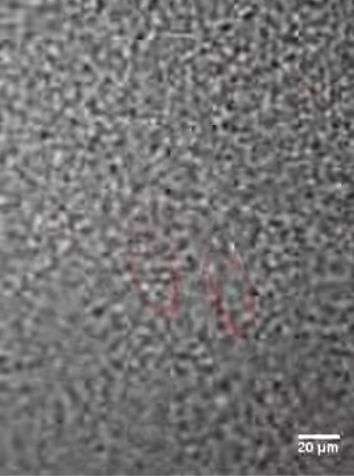January 24, 2017 report
Researchers find weak organization and collective oscillation in dense bacterial groups

(Phys.org)—A small team of researchers affiliated with several institutions in China has found that subgroups of bacteria within much larger groups sometimes organize and engage in collective oscillatory behavior. In their paper published in the journal Nature, the group describes the type of bacteria they were studying and their newly discovered activity.
Scientists know that cell groups oscillate; it is part of the way embryos develop, for example, and is the means by which neuron behavior is regulated. Scientists also know that many types of bacteria are able to communicate with others of their kind—through electrical signals and via molecular transfer. But until now, groups of bacteria organizing themselves into subgroups and oscillating within their group had never been seen. In this new effort, the researchers were studying Escherichia coli under a microscope and were surprised to see that at some points, small subgroups among the millions of cells under observation organized into an oval shape or loop and began to move around it, like tiny cars on a race track, demonstrating a form of subgroup oscillation.
As the researchers note, oscillatory behavior among cells is typically orchestrated via diffusive chemicals, electrical stimulation or biomechanical interaction, generally resulting in synchronized oscillatory behavior. The bacteria, on the other hand, did not appear to require any of these mechanisms, nor was their oscillatory behavior synchronized. Furthermore, the oscillations they exhibited were conducted in non-periodic, erratic fashion, and sometimes even involved directional changes. The team suggests it is likely the bacteria interact with one another locally via some as-yet unknown means—at the scale seen, an individual would not be able to "understand" the size of the loop being formed, and would therefore have to be governed by some unseen source. The researchers were not able to identify the reason for the creation of such oscillatory subgroups, or if those they saw moving around a loop caused any specified action to arise.
The researchers have provided video proof of the newly discovered behavior by the bacteria and suggest that it might be present in other scenarios in which very large groups of moving cells are present.
More information: Chong Chen et al. Weak synchronization and large-scale collective oscillation in dense bacterial suspensions, Nature (2017). DOI: 10.1038/nature20817
Abstract
Collective oscillatory behaviour is ubiquitous in nature, having a vital role in many biological processes from embryogenesis and organ development to pace-making in neuron networks. Elucidating the mechanisms that give rise to synchronization is essential to the understanding of biological self-organization. Collective oscillations in biological multicellular systems often arise from long-range coupling mediated by diffusive chemicals by electrochemical mechanisms, or by biomechanical interaction between cells and their physical environment. In these examples, the phase of some oscillatory intracellular degree of freedom is synchronized. Here, in contrast, we report the discovery of a weak synchronization mechanism that does not require long-range coupling or inherent oscillation of individual cells. We find that millions of motile cells in dense bacterial suspensions can self-organize into highly robust collective oscillatory motion, while individual cells move in an erratic manner, without obvious periodic motion but with frequent, abrupt and random directional changes. So erratic are individual trajectories that uncovering the collective oscillations of our micrometre-sized cells requires individual velocities to be averaged over tens or hundreds of micrometres. On such large scales, the oscillations appear to be in phase and the mean position of cells typically describes a regular elliptic trajectory. We found that the phase of the oscillations is organized into a centimetre-scale travelling wave. We present a model of noisy self-propelled particles with strictly local interactions that accounts faithfully for our observations, suggesting that self-organized collective oscillatory motion results from spontaneous chiral and rotational symmetry breaking. These findings reveal a previously unseen type of long-range order in active matter systems (those in which energy is spent locally to produce non-random motion). This mechanism of collective oscillation may inspire new strategies to control the self-organization of active matter and swarming robots.
Journal information: Nature
© 2017 Phys.org





















